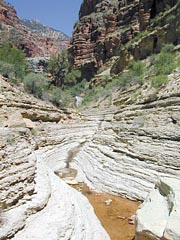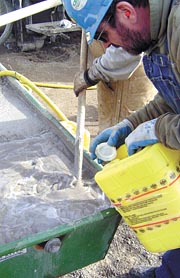
Tests focused on four partially hydrolyzed polyacrylamide (PHPA) polymer products from two manufacturers. Shale materials of Pennsylvanian and Devonian age were obtained from cores drilled at three locations. Specific laboratory experiments included preliminary Atterberg limits and mineralogical characterization, jar slake testing, slake durability (drum slake) testing, unconfined axial swell testing and bulk hardness testing. The last was conducted using a newly developed extrusion testing system.
The objective of each testing series was to quantify polymer slurry performance in terms of shale durability, swelling inhibition and softening behavior, as well as to explore the dependency of each of these performance variables on slurry type and concentration. Slurry concentration was varied from zero (tap water or distilled water) to 150 percent of the manufacturer recommended concentration in increments of 25 percent.

Observations and Conclusions
Some of the general conclusions reached from this study:1. Preparation of PHPA polymer slurries does not require prolonged mixing time. Uniform slurry was obtained as long as the polymer dissolved completely during initial mixing. Full realization of slurry viscosity (quantified using a Marsh funnel), however, required a significant amount of time after mixing (5 hours to more than 48 hours).
2. Solid-based (granular) polymer slurries considered in this study developed steady state Marsh funnel viscosity more rapidly (5-18 hours) than the liquid-based (emulsified) polymer slurries considered (> 48 hours).
3. Solid-based (granular) polymer slurries mixed to manufacturer recommended concentrations developed consistently higher Marsh funnel viscosities (approx. 57 sec./qt.) than liquid-based (emulsified) polymer slurries (approx. 39 sec./qt.).
4. The durability of shale specimens considered in this study using polymer slurries and quantified in terms of slake durability index were only slightly enhanced relative to baseline values for distilled water and not enhanced relative to baseline values for tap water.
5. There is no significant dependence on the type (manufacturer) or form (solid or liquid) of the polymer slurries considered in this study in terms of improvement to slake durability index.
6. The slake durability index increases with increasing polymer concentration and reaches an optimum value near 100 percent of the manufacturer recommended concentration.
7. The durability of shale specimens considered in this study using polymer slurries and quantified in terms of jar slake index were slightly enhanced relative to baseline values for distilled water and tap water. For the three shale types considered, jar slake indices increased from category 4 to 5, from 5 to 6, or did not change.
8. Swelling of unconfined shale specimens (quantified using unconfined free swell tests) appeared to be inhibited by the use of polymer slurry relative to baseline values measured using tap water. Optimum swelling inhibition appeared to be attained using slurries mixed exactly to manufacturer recommended concentrations. Additional tests using shale specimens with significant swelling potential are required to validate these observations.
9. Bulk hardness index (quantified using an extrusion apparatus) systematically increases with increasing polymer slurry concentration and reaches an optimum for slurries mixed exactly to the manufacturer recommended concentration.

Recommendations Offered
The practical product of this research is a demonstrated and documented series of laboratory procedures that may be conducted on a site-specific basis to more effectively specify polymer-based drilling fluids for applications in shale. The laboratory procedures allow the relevant shale/slurry performance variables (e.g., durability, swelling inhibition, hardness) and the effects of slurry type, concentration or other variables (e.g., pH) to be systematically and directly quantified, thus creating a useful framework for site-specific slurry specification. It is recommended, therefore, that soil/rock specimens obtained during future site investigations where polymer slurries are under consideration for drilled shaft construction should be tested. The objective of the laboratory effort should be to specify acceptable ranges of polymer slurry properties on a site-specific basis.The preliminary laboratory phase should include procedures to quantify three basic material (shale) properties - durability, plasticity and strength. Recommended tests to quantify these properties are jar slake, slake durability (drum slake), Atterberg limits testing and unconfined compression testing. These tests are recommended for their simplicity and because they are already routine to most site investigations (with the possible exception of slake durability). The numerical products of these tests then may be used as quantitative indices to assess whether or not the durability, swelling potential or strength of the shale under consideration meets some predetermined acceptance criteria. If one or more of the acceptance criteria are not met, then a more detailed investigation of the material's durability, plasticity and strength, and the dependency of these properties on interactions with drilling fluid, is warranted.
If, for example, slake durability index during the preliminary laboratory investigation is less than perhaps 50, then borehole integrity may be an issue during construction and detailed investigation using jar slake and drum slake tests and a variety of polymer slurries and slurry concentrations is warranted. Similarly, if the plasticity index is greater than some predetermined value, perhaps 30-35, then swelling and dispersion of the borehole wall may be an issue during construction, and detailed investigation of swelling behavior using unconfined axial swell tests and a variety of polymer slurries and slurry concentrations is warranted. Finally, if unconfined compressive strength is relatively low, then the shear strength of the shaft/borehole interface may be an issue, and more detailed investigation of softening effects using bulk hardness tests and a variety of polymer slurries and slurry concentrations is warranted.
The product of the detailed investigation is an optimum slurry type and concentration to ensure acceptable shale durability, inhibit swelling and reduce softening effects. Quality control criteria then can be matched to this specific polymer type and concentration to afford site-specific specification of acceptable ranges for that quality control criterion.
Future Research
The activities of this study have provided a framework for site-specific polymer slurry specification. Additional efforts to establish the acceptance criteria described above and to implement the proposed sequence to controlled full-scale operations are recommended.It is recommended that a representative from the slurry manufacturer be more closely involved in slurry specification and quality control. If practical, it is desirable to require in the specifications that a manufacturer's representative be present at the site during actual drilling operations to react to any changing field conditions.
The pH of the make-up (tap) water used for tests described in this experimental program was 8.48, which is near the lower limit of the manufacturer's recommended range of 8-10. Because pH was not examined as an experimental variable, the sensitivity of the slurry performance criteria examined in this study (durability, swell, hardness) to pH is not known. Additional tests are suggested to evaluate the impact of pH over a wide range of values. Any observed sensitivity to pH should then be evaluated in light of the expected range of values encountered in typical field drilling operations.
The current specification for viscosity quality control is given in terms of Marsh Funnel viscosity (MFV). While MFV is accepted widely in practice and historically has been adopted in drilling fluid specifications, there is some question about whether or not the Marsh Funnel is the most appropriate device for viscosity control. The results of this study show that funnel viscosities for polymer slurries are extremely sensitive to time since mixing. It is recommended that alternative viscosity standards be examined for potential adoption into viscosity quality control specifications. Direct measurement of plastic viscosity and yield point using a concentric rotational viscometer operated on site should be considered.
Development of such specifications would most likely require a study of how viscosity measurements for polymer slurries obtained using the system depend on slurry concentration, pH, time since mixing, and suspended solids content.
Laboratory and full-scale or reduced-scale field tests are recommended to quantitatively assess perimeter load transfer in drilled shafts constructed using polymer slurry techniques. Particular emphasis for the laboratory tests should be placed on investigating variables that tend to affect filter cake thickness (e.g., cake formation time, borehole fluid pressure) and how the filter cake thickness affects the concrete/borehole interface strength. Full-scale or reduced-scale field tests should be performed under controlled conditions to assess polymer slurry performance in terms of constructability and load capacity for drilled shaft applications. Ideally, multiple test sites should be selected to represent wide range of soil/rock types, integrity and strength.
Additional tests are recommended to continue the testing program using a wider variety of shale materials. Shales exhibiting higher swelling potential, more diverse mineralogy and lower durability than those examined are specifically recommended. These additional tests will allow the effectiveness of polymer slurries to be better evaluated for use in shale.
ND

Report Abusive Comment